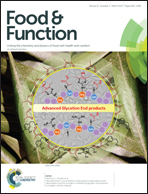Review on cell models to evaluate the potential antioxidant activity of polysaccharides
Abstract
Owing to various health functions, natural polysaccharides are becoming a kind of popular dietary nutritional supplement. At present, the occurrence of many chronic diseases is closely related to excessive reactive oxygen species (ROS). Note that polysaccharides with anti-oxidative activity have been paid significant attention as medicines, cosmetics, and food. Many documents constantly prove the effects of antioxidant polysaccharides against Alzheimer's disease, diabetes, and cardiovascular disease. Moreover, the structural features and functional properties of antioxidant polysaccharides have been extensively studied. Many chemical and biological methods have been used to evaluate the antioxidant activity of polysaccharides. Because of deficiencies in the accuracy and authenticity of the chemiluminescence method, the use of cell models has gradually become the mainstream method based on providing a more real biological environment. For these reasons, this study summarizes an overview of recent advances in cell models to evaluate the potential antioxidant activity of the polysaccharides. This study focuses on the advancements in the types of cell models and evaluation of the indexes of the potential mechanisms and factors that influence the anti-oxidative activity of polysaccharides. The aim is to provide useful background and updated information for further development and application of antioxidant polysaccharides.



 Please wait while we load your content...
Please wait while we load your content...